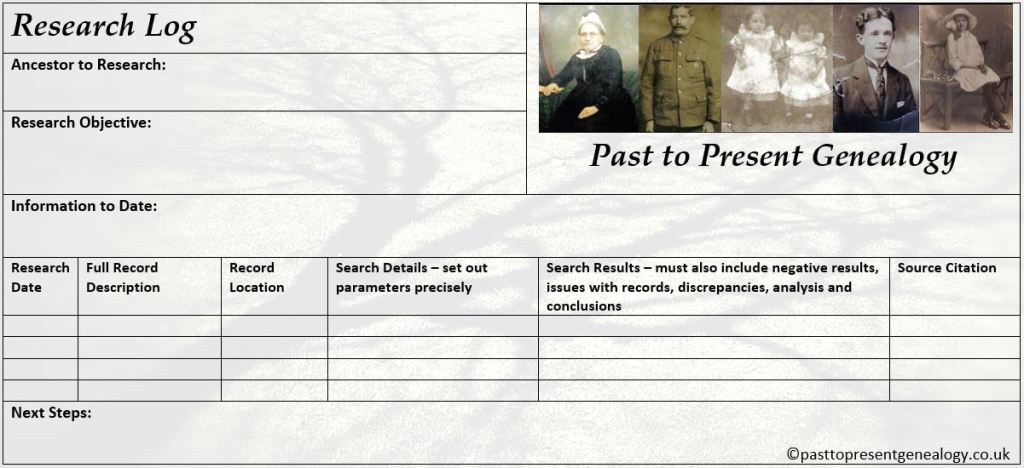Do these scenarios sound familiar?
- Halfway through a piece of research, do you realise you’ve done it before?
- Do you get broken off from your research, or shelve it, then pick up the problem months later – but can’t recall what you’d done or where you’d got to?
- Are you a scatter-gun researcher, flitting from one unplanned search to another, and at the end of a couple of hours you have no idea what records you’ve checked. Then go round in circles once more, repeating the same searches?
You’re not alone. But it means you’re wasting research time; you’re potentially overlooking key pieces of information; you are duplicating your efforts; and your research is unfocused.
Which is where a research log comes in.
A log makes for efficient research, with no wasted time or duplicated effort. You can pick up a piece of research months later and know exactly what steps have previously been taken. It also means you can more easily identify gaps in your research.
In short a log keeps your research on track.

My seven key points for research logs are:
- Define the research objective: Set out clearly the problem, e.g. finding out the date of birth of an ancestor, or who their parents were. Include what you know through evidence, and any assumptions or conflicting information. This enables identification of issues, leading on to potential sources and search strategies
- Identify possible records and sources (e.g censuses, parish registers, probate records, books): These must be fully detailed including description, location(s) and type e.g. original documents, indexes, transcripts, digitised images etc.
- Date of the search: Archives add to their acquisitions. Records are continually being digitised and appearing online, and this includes updates to ones already online (think 1939 Register, or the GRO Indexes). So a search conducted 12 months ago may not have the same outcomes if conducted today. A date helps you decide if it’s worth repeating the search.
- Set out fully the search parameters: What spelling variants did you use? How many years either side of a specific date did you search? Which locations/parishes did you use? Did you rely on a data provider’s online search? Did you visually confirm results? Did you go through the record (and all the years) yourself? If a book, did you rely on the index or read the entire chapter or book? Some datasets (e.g. censuses) are on multiple websites – did you search just one? The same search on another website may have a different result. This enables you to see exactly what has been done and identify other possible areas of research.
- Record in detail the results – including negative ones: Fully record search results along with your analysis, conclusions and any discrepancies. This includes problems with the records, e.g. were there any gaps or record damage which might affect the result? Do ensure that the explanation is clear because it might be a while before you revisit it. And do include negative searches.
- Full source citations: Note where the original document can be found. Include full document reference, with page number. For website searches also include URL, description and date accessed. Give as much information as possible to enable you to find the document again. Do not assume it will always be online!
- Next steps: Review your log. Identify follow-up searches.
Your log could be electronic (do remember to back it up). Or it could be paper-based.
There are lots of pro-formas online. I have included my example above. Or perhaps you might prefer to design your own bespoke log.
And do not be put off by the thought of the time taken to keep a research log. It is minimal when compared with the time you will save in the long run from trying to remember exactly what you’ve done before, reducing the number of repeat searches and pinpointing what you have not tried.
Whatever method you use, online or paper-based, your research will benefit.

